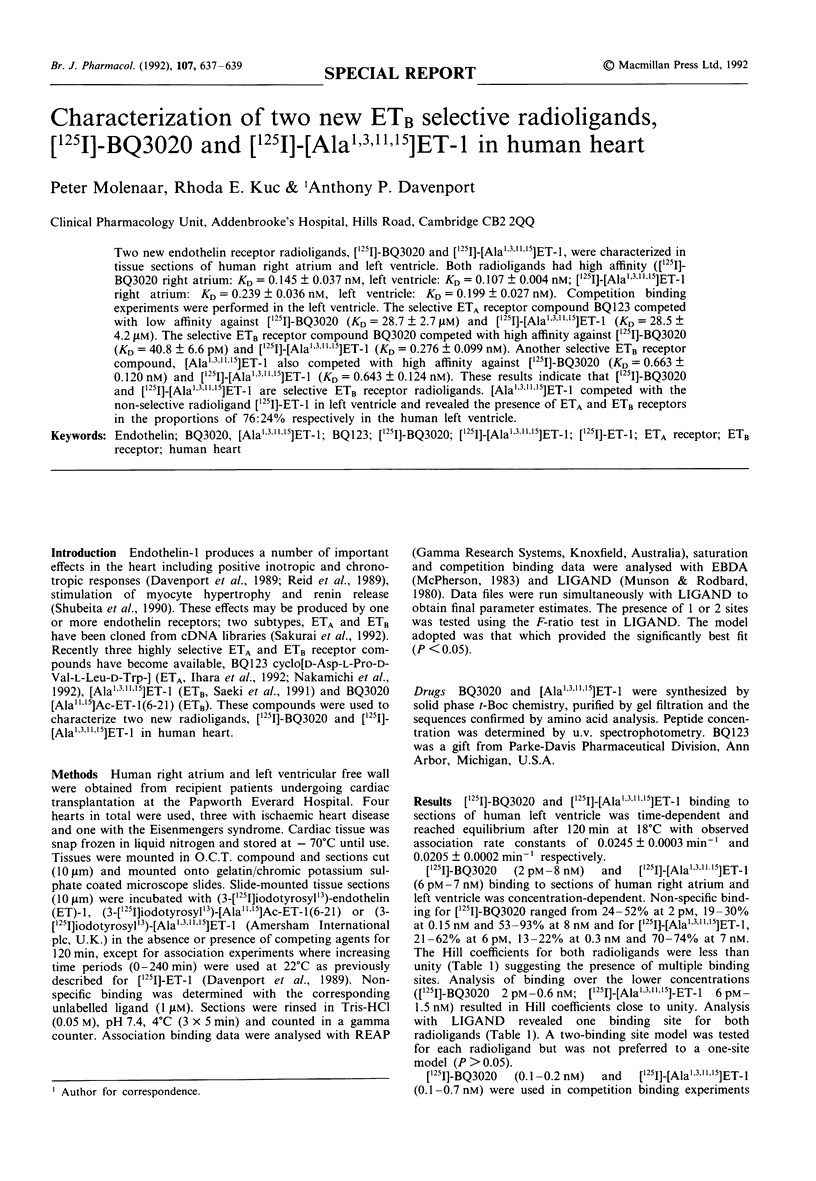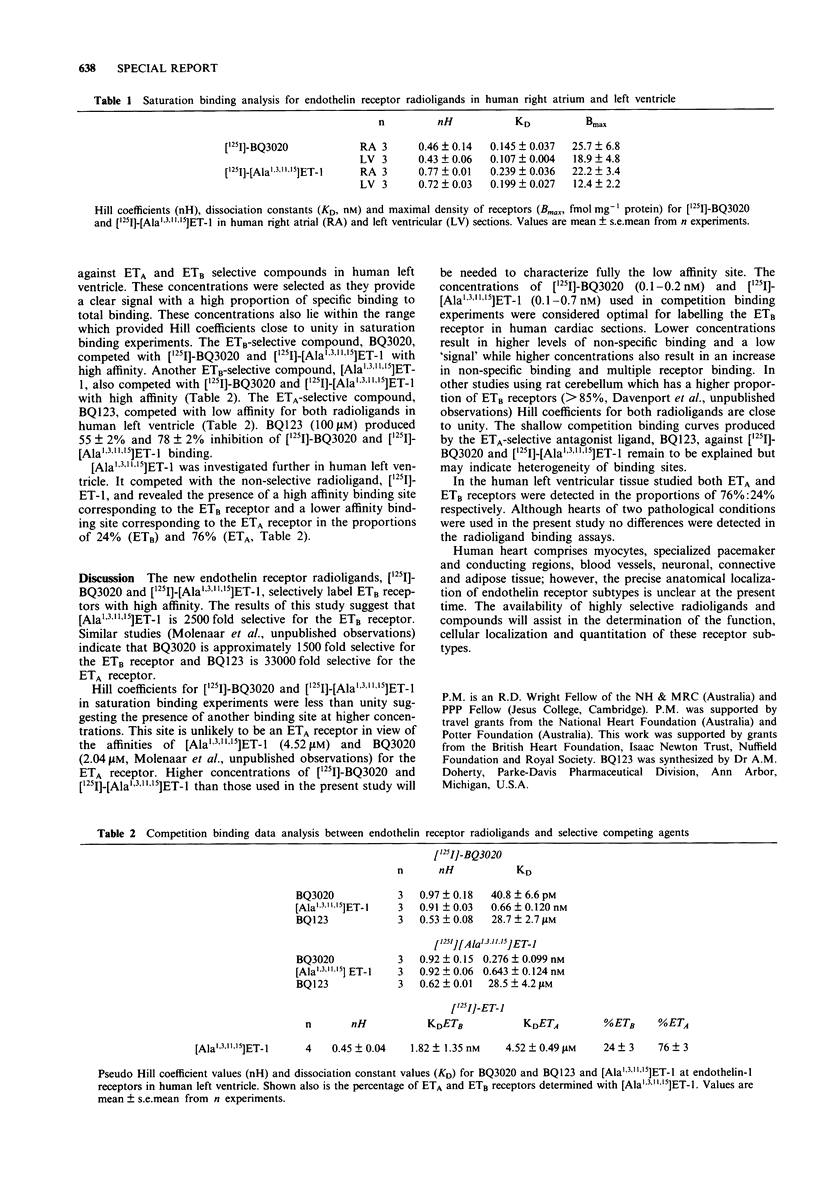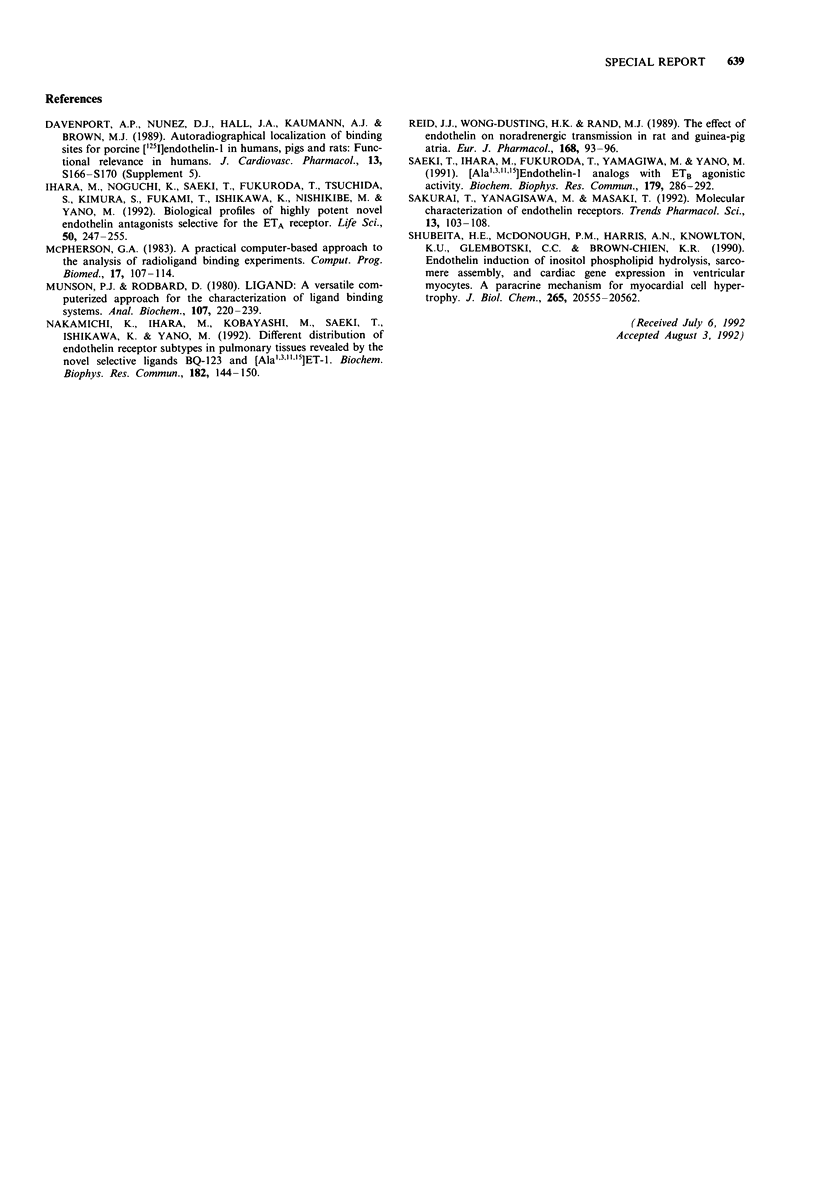Abstract
Two new endothelin receptor radioligands, [125I]-BQ3020 and [125I]-[Ala1,3,11,15]ET-1, were characterized in tissue sections of human right atrium and left ventricle. Both radioligands had high affinity ([125I]-BQ3020 right atrium: KD = 0.145 +/- 0.037 nM, left ventricle: KD = 0.107 +/- 0.004 nM; [125I]-[Ala1,3,11,15]ET-1 right atrium: KD = 0.239 +/- 0.036 nM, left ventricle: KD = 0.199 +/- 0.027 nM). Competition binding experiments were performed in the left ventricle. The selective ETA receptor compound BQ123 competed with low affinity against [125I]-BQ3020 (KD = 28.7 +/- 2.7 microM) and [125I]-[Ala1,3,11,15]ET-1 (KD = 28.5 +/- 4.2 microM). The selective ETB receptor compound BQ3020 competed with high affinity against [125I]-BQ3020 (KD = 40.8 +/- 6.6 pM) and [125I]-[Ala1,3,11,15]ET-1 (KD = 0.276 +/- 0.099 nM). Another selective ETB receptor compound, [Ala1,3,11,15]ET-1 also competed with high affinity against [125I]-BQ3020 (KD = 0.663 +/- 0.120 nM) and [125I]-[Ala1,3,11,15]ET-1 (KD = 0.643 +/- 0.124 nM). These results indicate that [125I]-BQ3020 and [125I]-[Ala1,3,11,15]ET-1 are selective ETB receptor radioligands. [Ala1,3,11,15]ET-1 competed with the non-selective radioligand [125I]-ET-1 in left ventricle and revealed the presence of ETA and ETB receptors in the proportions of 76:24% respectively in the human left ventricle.
Full text
PDF


Selected References
These references are in PubMed. This may not be the complete list of references from this article.
- Davenport A. P., Nunez D. J., Hall J. A., Kaumann A. J., Brown M. J. Autoradiographical localization of binding sites for porcine [125I]endothelin-1 in humans, pigs, and rats: functional relevance in humans. J Cardiovasc Pharmacol. 1989;13 (Suppl 5):S166–S170. doi: 10.1097/00005344-198900135-00045. [DOI] [PubMed] [Google Scholar]
- Ihara M., Noguchi K., Saeki T., Fukuroda T., Tsuchida S., Kimura S., Fukami T., Ishikawa K., Nishikibe M., Yano M. Biological profiles of highly potent novel endothelin antagonists selective for the ETA receptor. Life Sci. 1992;50(4):247–255. doi: 10.1016/0024-3205(92)90331-i. [DOI] [PubMed] [Google Scholar]
- McPherson G. A. A practical computer-based approach to the analysis of radioligand binding experiments. Comput Programs Biomed. 1983 Aug-Oct;17(1-2):107–113. doi: 10.1016/0010-468x(83)90031-4. [DOI] [PubMed] [Google Scholar]
- Munson P. J., Rodbard D. Ligand: a versatile computerized approach for characterization of ligand-binding systems. Anal Biochem. 1980 Sep 1;107(1):220–239. doi: 10.1016/0003-2697(80)90515-1. [DOI] [PubMed] [Google Scholar]
- Nakamichi K., Ihara M., Kobayashi M., Saeki T., Ishikawa K., Yano M. Different distribution of endothelin receptor subtypes in pulmonary tissues revealed by the novel selective ligands BQ-123 and [Ala1,3,11,15]ET-1. Biochem Biophys Res Commun. 1992 Jan 15;182(1):144–150. doi: 10.1016/s0006-291x(05)80123-8. [DOI] [PubMed] [Google Scholar]
- Reid J. J., Wong-Dusting H. K., Rand M. J. The effect of endothelin on noradrenergic transmission in rat and guinea-pig atria. Eur J Pharmacol. 1989 Sep 1;168(1):93–96. doi: 10.1016/0014-2999(89)90637-7. [DOI] [PubMed] [Google Scholar]
- Saeki T., Ihara M., Fukuroda T., Yamagiwa M., Yano M. [Ala1,3,11,15]endothelin-1 analogs with ETB agonistic activity. Biochem Biophys Res Commun. 1991 Aug 30;179(1):286–292. doi: 10.1016/0006-291x(91)91367-l. [DOI] [PubMed] [Google Scholar]
- Sakurai T., Yanagisawa M., Masaki T. Molecular characterization of endothelin receptors. Trends Pharmacol Sci. 1992 Mar;13(3):103–108. doi: 10.1016/0165-6147(92)90038-8. [DOI] [PubMed] [Google Scholar]
- Shubeita H. E., McDonough P. M., Harris A. N., Knowlton K. U., Glembotski C. C., Brown J. H., Chien K. R. Endothelin induction of inositol phospholipid hydrolysis, sarcomere assembly, and cardiac gene expression in ventricular myocytes. A paracrine mechanism for myocardial cell hypertrophy. J Biol Chem. 1990 Nov 25;265(33):20555–20562. [PubMed] [Google Scholar]


